
About the water filter. (on some models) GEAppliances.com
7
Water Filter Cartridge
The water filter cartridge is located in the back upper right
corner of the refrigerator compartment.
When to Replace the Filter on Models With a
Replacement Indicator Light
There is a replacement indicator light for the water filter
cartridge on the dispenser. This light will turn orange to tell you
that you need to replace the filter soon.
The filter cartridge should be replaced when the replacement
indicator light turns red or if the flow of water to the dispenser or
icemaker decreases.
When to Replace the Filter on Models Without a
Replacement Indicator Light
The filter cartridge should be replaced every six months or
earlier if the flow of water to the water dispenser or icemaker
decreases.
Removing the Filter Cartridge
If you are replacing the cartridge, first remove the old one by
slowly turning it to the left. Do not pull down on the cartridge. A
small amount of water may drip down.
Installing the Filter Cartridge
If you are replacing a SmartWater cartridge with an
adapter, it must be removed before installing the cartridge.
To remove the adapter, turn it to the left about 1/4 turn.
If you are replacing a Water by Culligan cartridge, leave the
adapter in place. This adapter will stay in the refrigerator
when you replace future cartridges.
On models ithout a replacement indicator light, apply the
month and year sticker to the new cartridge to remind you
to replace the filter in six months.
Fill the replacement cartridge with water from the tap to
allow for better flow from the dispenser immediately after
installation.
Line up the arrow on the cartridge and the cartridge holder.
Place the top of the new cartridge up inside the holder. Do
not push it up into the holder.
Slowly turn it to the right until the filter cartridge stops. DO
NOT OVERTIGHTEN. As you turn the cartridge, it will
automatically raise itself into position. The cartridge will
move about 1/2 turn.
Run water from the dispenser 1-1/2 gallons (about three
minutes) to clear the system and prevent sputtering.
Press and hold the WATER FILTER pad (on some models) on
the dispenser for 3 seconds.
NOTE: A newly-installed water filter cartridge may cause water
to spurt from the dispenser upon first use.
Filter Bypass Plug
You must use the filter bypass plug when a replacement filter
cartridge is not available. The dispenser and the icemaker will
not operate without the filter or filter bypass plug.
To use the filter bypass plug on Water by Culligan models, you
must first remove the filter adapter from the cartridge holder by
turning it to the left.
For the maximum benefit of your filtration system, GE
recommends the use of GE branded SmartWater filters only.
Using GE branded filters in GE and Hotpoint refrigerators
provides optimal performance and reliability. GE branded
SmartWater filters are always the right choice because they
are patented and designed specifically for GE products. GE
SmartWater filters meet rigorous industry NSF standards for
safety and quality that are important for products that are
filtering your water. GE has not qualified non-GE branded
filters for use in GE and Hotpoint refrigerators and there is no
assurance that non-GE branded filters meet GE’s standards for
quality, performance and reliability.
,I\RXKDYHTXHVWLRQV³YLVLWRXU:HEVLWHDWGEAppliances.com,
or call 1.800.GE.CARES (1.800.432.2737).
Replacement filters:
To order additional filter cartridges in the United States, visit our
Website at GEAppliances.com, or call GE Parts and Accessories,
800.626.2002.
See filter label for type of filter to order (MWF or MSWF).
Customers in Canada should consult the yellow pages for the
nearest Mabe Service Center.
Filter
Bypass
Plug
Filter
Bypass
Plug
SmartWater
Water by Culligan
(appearance may vary)
With adapter
Without adapter
Cartridge
Holder
Some models
use this type of
water filter.




















